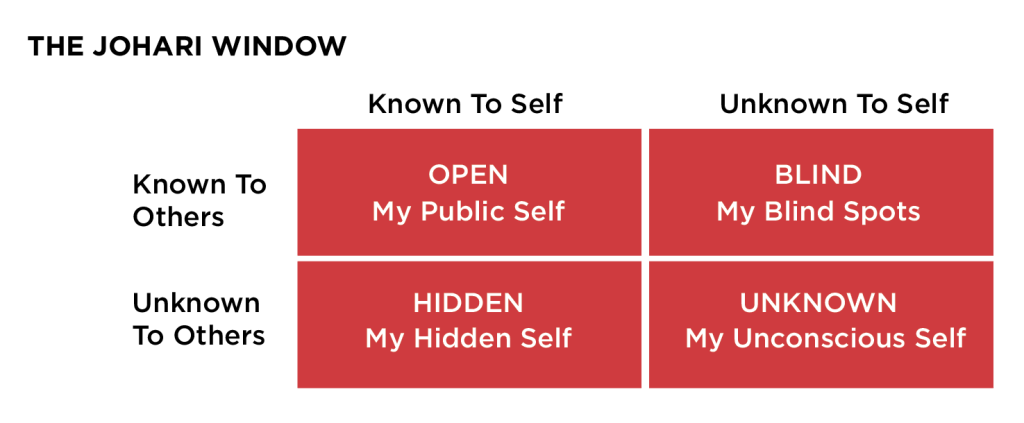This “Sight Line” is provided as a supplement to Chapter 1 of 20/20 Mind Sight, “What the Hell is Water?” Put the “I” In You.
For maximum benefit, please read the chapter prior to completing the exercise.
20/20 Sight Line: The Johari Window
On a daily basis we deal with three conflicting realities about ourselves:
- The You as you see yourself
- The You as you’re seen by others
- The You as you want to be seen by others
The Johari Window is a psychological tool developed in 1955 and named for its inventors, Joseph Luft and Harry Ingham. It provides a useful model to explore the interplay among our various interpersonal realities and gain insight into how we see ourselves versus how others see us.
The Johari Window distinguishes between what you know and don’t know about yourself, and what others know or don’t know about you. It then plots the overlaps, inconsistencies, and gaps into a four-paned “window” as depicted in the accompanying graphic. Each of the four window “panes” provides insight into a specific aspect of our communications and relationship-building behaviors.

- Open — This quadrant reflects your “public self” and includes “open” topics that are presented and observed with honesty and little defensiveness.
- Blind — Think of this as the “spinach in the tooth” quadrant. Interpersonal communication in this pane tends to be hesitant and circumspect because others aren’t quite sure what you know or don’t know. Your goal is to make this pane the smallest of the quadrants.
- Hidden — If you have a skeleton in your closet, it lives here. To some extent, you control the flow of communication regarding information in this quadrant and share personal details only as circumstances and comfort levels dictate.
- Unknown — This is the province of Freud and Jung where the unconscious reigns supreme. We don’t know what we don’t know and neither do the people we associate with. In terms of creating a 20/20 mindset, this quadrant has limited application.
We doubt that Lily Tomlin was referring to the Johari Window when she said, “I always wanted to be somebody, but I should have been more specific;” but her remark speaks to the primary benefit of this self-assessment tool. The Johari Window provides an opportunity to better align the realities, perceptions, and aspirations of your inner self — and better experience yourself as others do.
As a self-actualization tool, the Johari Window is quite easy to use. We strongly recommend that you create your Johari baseline profile and then invite at least a dozen friends, colleagues, and family members to provide their own input. The feedback will move you one step closer to recognizing and understanding the actual “I” that resides in “You.” Access the Johari Window.
Extra Credit
The only criticism we’ve ever heard about the Johari Window exercise is that it only includes positive traits. If you’re willing to run the risk of a walk on the wild side, you can also check out Johari’s evil twin: the Nohari Window.
See below to check out what others have shared about their experiences
with this chapter and Sight Line. Please click to add your feedback too!